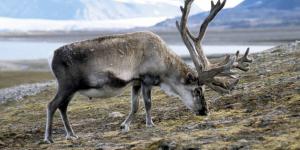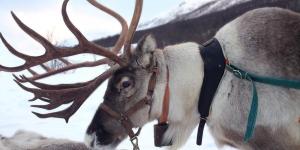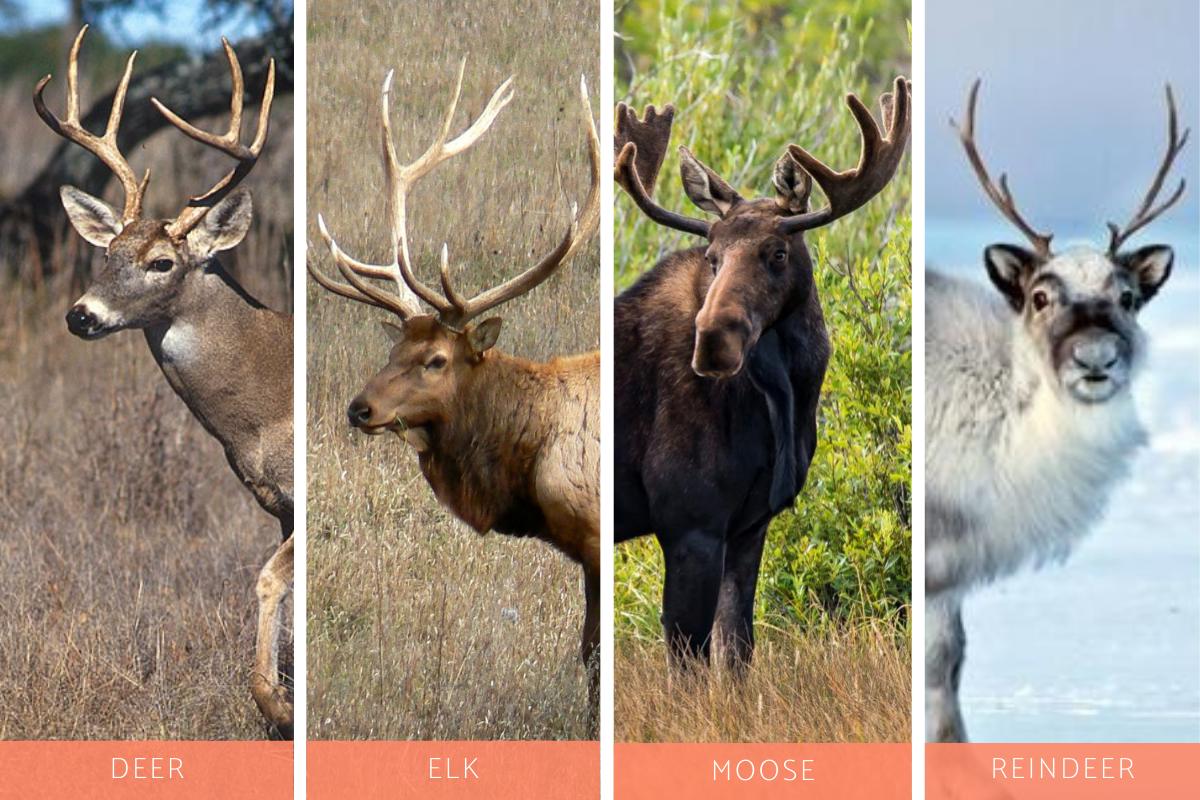Differences Between Deer, Elk, Moose and Reindeer

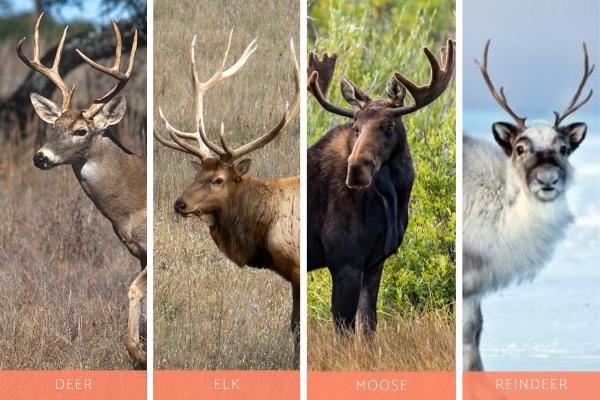
Deer, elk, moose and reindeers are physically similar to each other due to the fact that they are part of the same family, the Cervidae family. This family includes 43 species of hoofed mammals.
In this AnimalWised article we're going to explain the difference between deer, elk, moose and reindeer. Keep reading to learn more!
Are they all deer?
The problem with knowing the differences between deer, elk, moose and reindeer is a taxonomic one. Taxonomy is the process of classification. Animals are grouped into different classes for various reasons, partly so we can simply keep track of them. By grouping similar animals together we can better understand the relationships they have between each other.
We discuss deer, elk, moose and reindeer in this article. The first thing to understand is that all of these animals are part of the same group of mammals known as the Cervidae family. Animals in the Cervidae family are all a type of deer, but not all of them are given this name. All deer are hoofed ruminant animals which fall into two categories: Cervinae and Capreolinae.
Cervinae
This group of deer is known as Old World deer, although many species now live in other parts of the world. Part of the reason they are broken up into different groups is because they evolved separately at one stage. Deer in the group Cervinae include:
- Elk
- Muntjac
- Chital
- Tufted deer
Capreolinae
Known as New World deer, animals in this subfamily of deer are differentiated by their ankle bone structure. Capreolinae are telemetacarpel deer, retaining certain metacarpals which Cervinae deer, known as plesiometacarpal deer, do not. Deer in this group include:
- Moose
- Reindeer
- Roe deer
While these two deer groups differ slightly in bone structure, it is their similarities which mean they are both still types of deer. As ruminant animals, deer of all types have stomach divided into four compartments. These compartments allow the food to be first fermented before being digested and metabolized. This type of digestion requires the food to be chewed extensively, a process known as ‘rumination’, hence their name.
Another key characteristic all deer share is the fact that they are ungulates. This means they are mammals with hooves. There are many different type of ungulate animals. Having hooves does not make an animal a deer, but an animal won't be a deer without them.
Although all male deer grow antlers, only some female possess this ability. There is one exception which is the water deer. This deer is still a true deer, but instead of antlers, they have tusks which grow out of their mouth where canine teeth would be on some other mammals. Although a true deer, the water deer looks very similar to the musk deer. Despite their name, the musk deer is not a true deer and has other differences such lacking certain glands.
With such similarities between true deer and other similar animals, it is understandable why we might be confused about the differences between deer, elk, moose and reindeer. This is why we explain further below.
What are deer like?
There are several genera of deer, including Axis (chital), Cervus (which include elk), Dama (fallow deer), Elaphodus (tufted deer) and Muntiacus (Muntjac). As we state above, we cannot say that elk, moose and reindeer are different from deer because they are all deer species. A large part of the confusion when comparing elk to deer or moose compared to deer us because the names are often misleading. For example, a moose is a type of deer, but a musk deer isn't.
Different types of deer can be found all over the world, except for Oceania and Antarctica. In North America, you can find reindeer, moose, elk (also known as wapitis) and animals we simply refer to as ‘deer’. The smallest of the four is the deer, of which you can find two different native species: the mule deer (Odocoileus hemionus) and the white-tailed deer (Odocoileus virginianus).
In general, white-tailed deer are smaller, reaching a mature weight of anywhere between 100 and 300 lb (45 to 135 kg). They can move at speeds of up to 30 mi/h (50 km/h), and they are able to clear 10-foot (3 m) fences.
The deer's distribution and habitat includes forests, desert areas, and grasslands. Deer grow their long, forked, pointed and/or curved antlers during spring and summer, but shed them through winter. Deer sounds are few and extremely rare. Learn more in our article about how and why deer shed their antlers.
If you are in a relatively low latitude and you see a cervid moving fast and jumping gracefully, it is most likely a deer and not an elk or a reindeer.
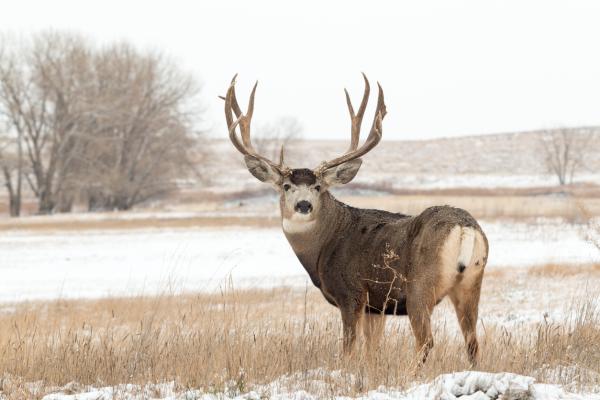
What are elk like?
Some people try to make the comparison between elk vs deer, but as we have explained this doesn't make sense. An elk is a type of deer, so we need to be more specific when comparing certain animals. Elk (Cervus canadensis), called wapiti in Europe, are one of the largest deer species.
An elk's withers reach about 5 ft (1.5 m) from the ground, and the male's antlers can reach up to 4 feet (1.2 m) above the head, which gives them a total of 9 feet (2.75 m) in height. Elk can range from 500 to 1,300 pounds (225 to 600 kg): males are larger than females.
Elk reside in mountainous forests across North America (except from the northernmost regions) and East Asia. They spend the majority of their time along the forest edges. In America, they have adapted to living in desert and semi-desert regions such as the Great Plains. They travel in large herds, which can number 1,000 individuals, and they can run at 45 mi/h (70 km/h).
Their necks are shaggy, which makes them easy to identify from other deer species. Their coat color and thickness changes depending on the climate, although they usually have dark necks and pale rumps.
Another key difference between elk and deer, moose and reindeer is that male elk have a loud, high-pitched bugle which they sound during the morning and evening. On the other hand, deer only make occasional bleats. There are also differences in diet: elks are browsers while deer are grazers.

What are reindeer like?
Reindeer (Rangifer tarandus) are also known as caribou, causing some to think they are two different animals. They are similar in size to elk, also reaching 5 ft (1.5) at the withers and 6 ft 6 (2 m) in length. While they are large animals, their body weight varies from 175 to 460 pounds (80 to 210 kg).
Both male and female reindeer grow antlers, making them easy to differentiate reindeer from other types of deer. Fur color varies among individuals and subspecies: northern reindeer are lighter as opposed to their southern counterparts.
Reindeer live in mountainous forests, but also in sub-Arctic boreal forests and tundra regions. The further north you are, the likelier it is you are seeing a reindeer and not a moose or an elk. Like elk, reindeer live in large herds. They reside in North America and Eurasia, and there are different subspecies based on their geographical range. Of course, reindeer play a key role in Christmas mythology.
The main differences between elk and reindeer is that the former are heavier, while the latter have larger antlers relative to their body size. Moreover, a reindeer's antlers are covered in velvet, while an elk's are not.
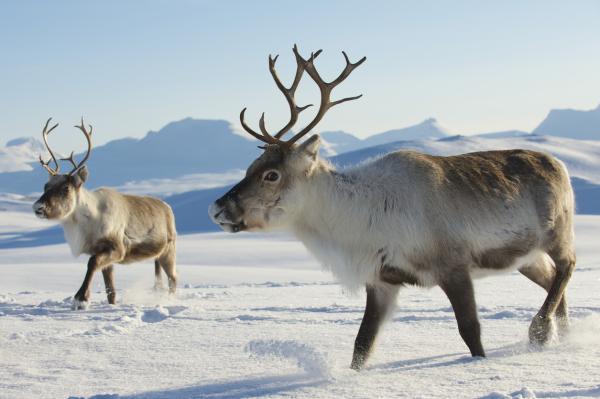
What are moose like?
Moose (Alces alces) are called elk in Europe, which makes them easy to confuse with North American elk or wapitis. However, their flat, wide antlers and strange-looking bulky face differentiates them from the other types of deer.
Moose are the largest deer species in the world. If you see a deer that's more than 6 ft 9 (2 m) at the withers, it is definitely a moose. The male's antlers are 4 ft 9 (1.5 m) wide. Like elk, moose are browsers and not grazers, which differentiates them from deer. Browsing is a type of animal behavior performed by animals known as ‘concentrate selectors’. The animals choose to eat low-fiber diets which are high in other types of nutrition. Their metabolic system has been able to adapt over the years to this type of diet.
Moose live in a similar habitat as elk and reindeer, although they prefer temperate and cool climates and forests. They do not leave in herds: moose are solitary animals. While the different types of deer have a wider geographical reach, moose can be found in the northern regions of North America, especially in Canada and Alaska, the coldest regions of Europe, especially in Scandinavia and the Baltic republics, and some areas of Russia and China.
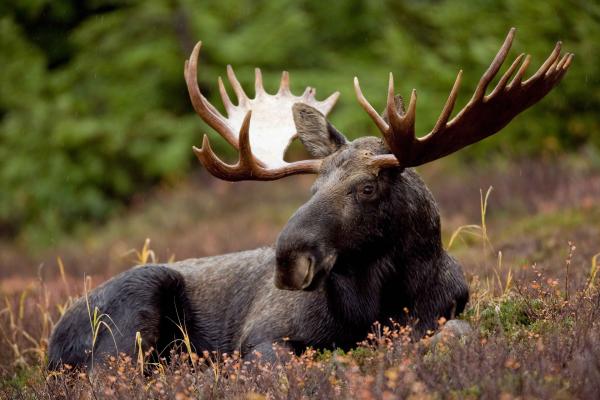
Now that you know the main differences between deer, elk, moose and reindeer in size and habitat, don't miss the following articles:
- Differences between kangaroos and wallaby
- Differences between alligators and crocodiles
- Differences between crows, ravens and rooks
To get a visual representation of the differences between different deer species, we can see the below video. In it is a depiction of a stag red deer squaring off against an elk. Despite red deer being one of the largest deer species, they are significantly smaller than their related elk.

If you want to read similar articles to Differences Between Deer, Elk, Moose and Reindeer, we recommend you visit our Facts about the animal kingdom category.


